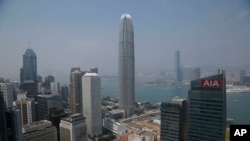Hong Kong leaders say they want their city to play a vital role in China’s plan for a 21st century new Silk Road over land and sea, linking Asia, the Middle East, Europe and Africa.
In an interview with VOA this week, Regina Ip, legislator and chair of the Beijing friendly New People’s Party, said Hong Kong’s ties to mainland China and it’s neighbors make it an ideal gateway for the Silk Road strategy.
“We have a lot of overseas Chinese associations in Hong Kong. You know in the Philippines, 99 percent of the Chinese are [originally from China’s Fujian province], and we have one million Fujianese in Hong Kong," she said. "So we are well connected with Asian business communities, as well as with overseas Chinese.”
She also echoed comments by Hong Kong Chief Executive C.Y. Leung, who in January predicted Hong Kong will be a super-connector city, linking Chinese companies with outbound investment opportunities across Asia.
"The financing need for these infrastructure projects as they get underway will far exceed the funds provided by AIIB or the Silk Road Fund, so Hong Kong could contribute enormously as a fundraising platform,” said Ip.
A huge endeavor
China’s so-called One Belt, One Road strategy encompasses 65 nations and 4.4 billion people, with plans for massive investments in ports, infrastructure, roads and railways along the old Silk Road. Beijing hopes the plan will help rid China of excess capacity, and boost the profits of Chinese companies amidst the country’s economic slowdown.
Last year China invested more than $13 billion in 49 countries along the route, up 36.7 percent from the year before. As part of China’s plan for further investment through its Silk Road strategy, Hong Kong, Guangdong and Macau will form a Big Bay area, linking maritime routes and serving as a financing hub.
Raymond Yeung, a senior economist with ANZ bank, said, “You do need a market to support the fundraising and bond issuance to some extent. So probably Hong Kong can perform that role.”
As the world’s leading offshore Chinese currency financial center, Hong Kong could benefit from Beijing’s Silk Road plans; the One Belt, One Road strategy could also allow Hong Kong exporters to more easily shift manufacturing facilities from mainland China to other Asian countries along the Silk Road, where labor costs are cheaper.
Trade and investment
China’s promotion of the Asian Infrastructure Investment Bank and creation of a Silk Road Fund aims to speed investment in countries along the corridor.
Signs of that investment are already visible. In February a cargo train traveled from China to Iran for the first time.
“China’s belt and road strategy is a long term play, and it will take time to get large infrastructure projects off the ground," said Ben Simpfendorfer, a managing director of Silk Road Associates. "It will also be unevenly felt throughout the region, so you will see deals in Kazakhstan or Pakistan, but it will take longer to see deals in the Philippines or Vietnam.”
Over the next ten years, annual trade between China and nations along the Silk Road is estimated to reach more than $2.5 trillion.













